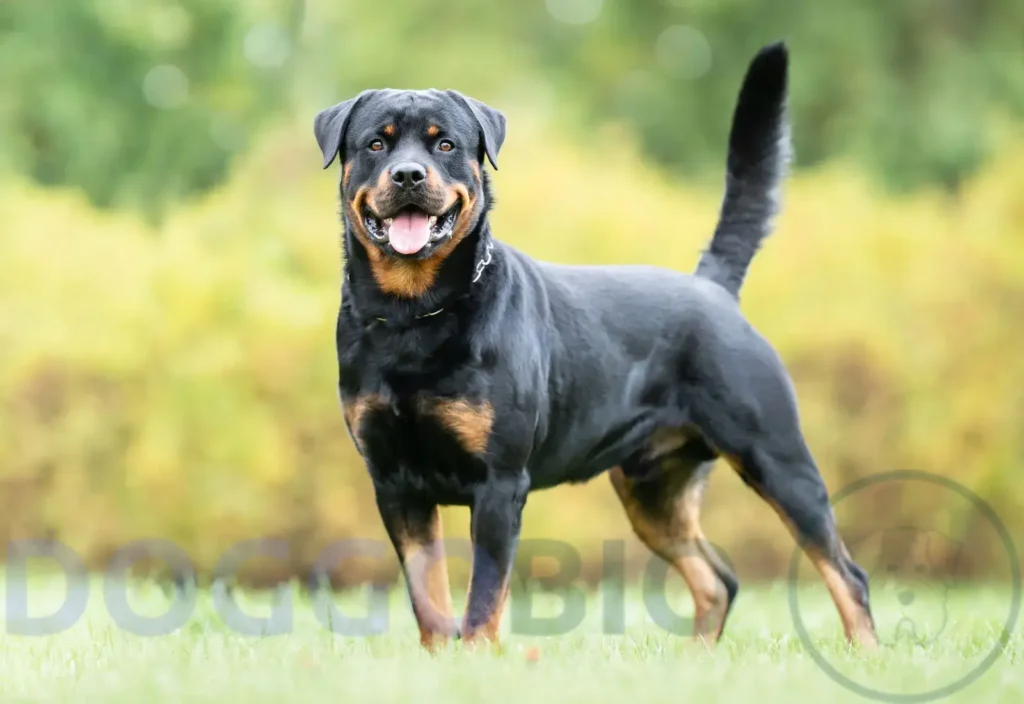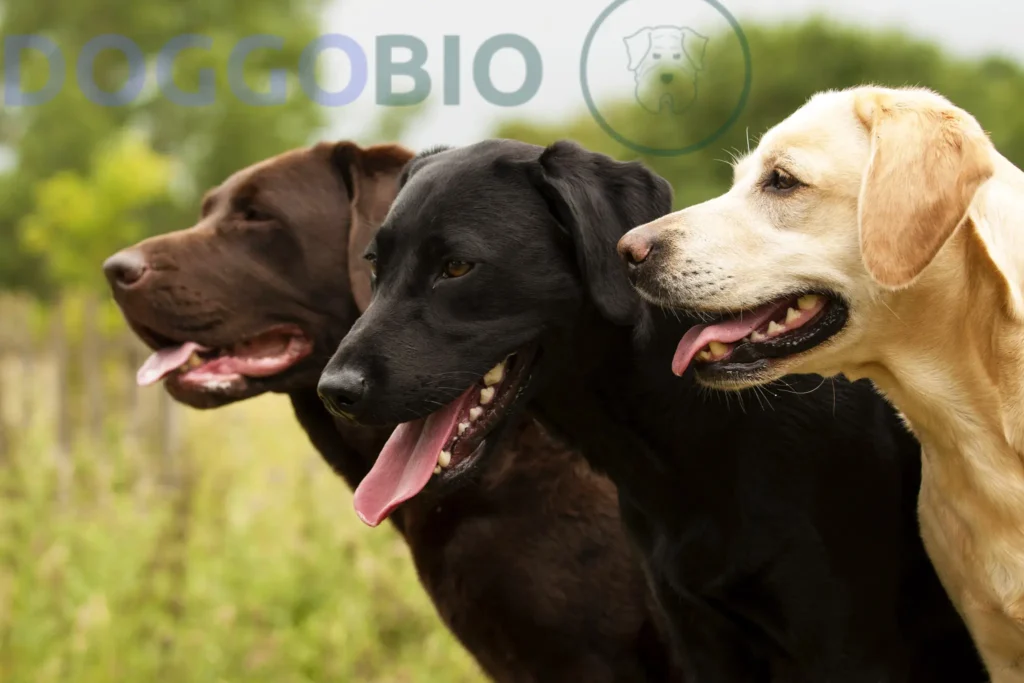The Rottweiler Lab Mix, also known as a Rottador or Labrottie, is a captivating canine breed that brings together the robust nature of the Rottweiler and the amiable personality of the Labrador Retriever.
With its distinctive appearance and winning character, this hybrid breed has captured the hearts of dog lovers worldwide.
This article will explore the unique qualities and characteristics that make the Rottweiler Lab Mix a remarkable companion for dog lovers worldwide.
A Brief Overview of Rottador
| Weight Range | 70-115 lbs (average) |
| Height | 24 inches (average) |
| Size | Large |
| Coat Type | Double coat; short to medium length |
| Coat Colors | Black, brown, gray, or combination of black and tan |
| Shedding | Moderate |
| Temperament | Family-friendly, loving, intelligent, energetic, active, and protective |
| Life Expectancy | 9-12 years |
| Hypoallergenic | No |
| Kid Friendly | No |
| New Owner Friendly | No |
| Breed Recognition | International Designer Canine Registry (IDCR), Designer Dogs Kennel Club (DDKC), American Canine Hybrid Club (ACHC), Dog Registry of America (DRA), Designer Breed Registry (DBR) |
What is Rottweiler Lab Mix?
The Rottador, a mix of Rottweilers and Labradors, likely emerged through intentional breeding in North America around the 1990s. Breeders aimed to create a healthier hybrid with desirable traits for families and watchdogs. As demand grew, more Rottadors were bred.
Parents of Rottador
The Lab Rottweiler Mix, also known as the Rottweiler Lab Retriever Mix, is a designer dog that combines the gentle Labrador and the strong Rottweiler. This mixed breed inherits traits from both parent breeds, resulting in a unique blend of personalities.
History of Rottweiler

The Rottweiler breed has a rich history that traces back to the Mastiff dogs brought by the ancient Romans to Germany during their conquests. Over time, the breed evolved and became prominent in Rottweil, primarily utilized by butchers to protect their possessions.
As the years went by, Rottweilers expanded their roles to include working as police and guide dogs. Their heritage as a versatile and protective breed is deeply rooted in their historical origins.
History of Labrador Retrievers

Labrador Retrievers have a fascinating history that dates back to the late 19th century in Great Britain. They were developed from hunting dogs that were imported from Newfoundland, Canada.
These dogs had a waterproof coat that made them well-suited for retrieving fish from the frigid waters of the northern Atlantic. Their exceptional retrieving skills and friendly disposition earned them recognition by the American Kennel Club (AKC) in 1917. Since then, Labradors have skyrocketed in popularity and have become one of the most beloved and cherished breeds worldwide.
What Does a Rottweiler Lab Mix Look Like?
A Rottweiler Lab Mix exhibits a blend of traits from both parent breeds, resulting in a varied appearance.
They often possess the robust build of the Rottweiler coupled with the gentle expression of the Labrador. While their head shapes can range from broad like a Labrador to slightly arched akin to a Rottweiler, their eyes are typically medium-sized and come in brown or hazel. Ears are usually triangular and forward-hanging.

Size, height, and Weight
The size of the Rottador can vary due to its status as a newer mixed breed. While there are no strict size standards, being a combination of Rottweiler and Labrador parents, the Rottador tends to be on the larger side.
Typically, they weigh between 70 to 115 pounds and stand at a height of 24 to 27 inches at the shoulder. However, it’s important to note that there can be variations, with some individuals being smaller or larger.
| Height Range | Weight Range | |
| Male | 24-27 inches | 90-120 pounds |
| Female | 22-25 inches | 70-100 pounds |
Coat Colors and Types
Rottador coats come in various colors, including black, brown, and grey.
Their medium-to-short, dense coats are relatively low-maintenance. Weekly brushing and occasional baths are usually sufficient. Their double coats help them adapt to different weather conditions. While they do shed, regular grooming can minimize the issue. It’s essential to keep Rottadors as indoor dogs.
Temperament and Personality
The Rottador is known for its affectionate nature, making it an ideal family pet and reliable watchdog. With a blend of Rottweiler’s protectiveness and Labrador’s friendliness, they’re initially cautious around strangers but become loyal companions once bonded.
Coming from working backgrounds, Rottadors inherit traits from both parent breeds, excelling as guard dogs like Rottweilers and versatile workers like Labradors. They thrive on attention and training, but require consistent engagement to prevent boredom and behavioral issues.
Training and Exercise Requirements
Positive training techniques are essential for shaping the obedience and temperament of your Rottweiler Lab mix. Avoid punishment-based methods, as they can lead to disobedience and aggression. Training your Rottador as a puppy and providing proper socialization is crucial for their development.

Regular exercise is vital for the well-being of your Labrottie. Both Rottweilers and Labs are active breeds requiring ample physical activity to maintain a healthy weight. Ensure they have sufficient space to run and play, as lack of exercise and overeating can lead to obesity and related health issues.
Grooming and Cleaning
Keeping your Rottweiler Lab mix groomed is straightforward due to its short hair. Weekly brushing with a soft-bristled brush maintains a glossy coat. Expect moderate shedding, especially in summer due to its double coat. More grooming may be needed during this time. Consider a robust vacuum for tidying up.
Due to its active lifestyle, monthly baths may be necessary to keep your dog clean. Daily tooth brushing is ideal, but a few times a week can work. Regular ear cleaning and nail trimming are essential for overall well-being.
| Grooming Needs | Grooming Frequency |
| Bathing | Every 6-8 weeks |
| Brushing | 2-3 times per week |
| Teeth Brushing | 3-4 times per week |
| Ear Cleaning | Check weekly |
| Nail Trimming | As needed |
Food and Diet
When feeding your Rottador, choose a diet suitable for large, energetic breeds. Avoid overfeeding and establish a regular feeding schedule. Consult your vet for specific dietary recommendations based on your dog’s age, Weight, and health. Remember to adjust their diet as they grow and age.
Life Expectancy and Common Health Issues
While robust, the Rottweiler Lab mix is prone to health issues common in larger breeds. These include allergies, bloat, bone cancer, ear infections, epilepsy, eye problems, hip dysplasia, and obesity.
Hip dysplasia, a concern for both parent breeds, can lead to joint degeneration and mobility issues. Prompt vet attention is vital if stiffness is observed. Exercise-induced collapse, seen in Labradors, warrants veterinary care if experienced.
Other conditions to monitor include acute moist dermatitis, cold tail, hypothyroidism, myopathy, and OCD. Health testing is essential for responsible breeding. Their lifespan ranges from 8 to 12 years, depending on overall health.
How Much Is Rottweiler Lab Mix?
The price of a Labrador Rottweiler Mix is relatively affordable compared to purebred dogs. Typically, the price for a Rottweiler Lab Mix falls within the range of $400 to $700.
Is a Rottador the Right Dog for You?

The Lab Rottweiler is a fantastic dog but unsuitable for everyone. This strong and intelligent breed requires an experienced owner who can provide firm leadership. They thrive in an active lifestyle and need regular exercise. Small apartments and sedentary lifestyles are not suitable for them.
Consider another companion if you have a busy schedule or are frequently away. The Rottweiler Lab mix could do better when left alone for long periods. They require mental stimulation and can exhibit destructive behavior if bored. Families with young children should also consider a different breed due to their size and energy.
For the right person, the Lab Rottweiler can be a fantastic companion. They need an active owner who can match their energy levels. With dedication and time, you’ll earn the love and loyalty of this lovable giant who will go to great lengths to protect his family.
List of dogs that are similar to Rottweiler Lab Mix
Frequently Asked Questions
Do Rottweiler Lab Mixes Shed A Lot?
Yes, Rottweiler Lab Mix dogs do shed. They have a moderate shedding level throughout the year, with heavier shedding occurring during the fall and spring months as they shed their undercoat in preparation for the changing seasons. Regular brushing can help manage their shedding and keep their coat in good condition.
Are Lab Rottweiler mixes hypoallergenic?
No, Labrador Mixed with Rottweiler is not a hypoallergenic breed. These dogs are moderate shedders; their dander and dried saliva can stick to loose fur, potentially causing allergic reactions in sensitive individuals.
If you have allergies, it is essential to spend time with a Lab Rottweiler mix before bringing one into your home to see if you have any adverse reactions. Regular grooming and cleaning can help minimize allergens but not eliminate them.
Conclusion
In conclusion, the Rottweiler Lab Mix is a remarkable canine companion that embodies the best of both the Rottweiler and the Labrador Retriever. With their striking appearance, unwavering loyalty, intelligence, and affectionate nature, these dogs have captured the hearts of many.
Whether seeking a devoted family companion, a diligent working dog, or an active playmate, the Rottweiler Lab Mix has much to offer. You can experience a lifelong bond filled with strength, loyalty, and endless joy by providing them with the love, care, and attention they deserve.

Pingback: Chihuahua Lab Mix: Tiny, Loyal Love Bundle 2024
Pingback: Vizsla Lab Mix: Fusion of Energy and Elegance 2024